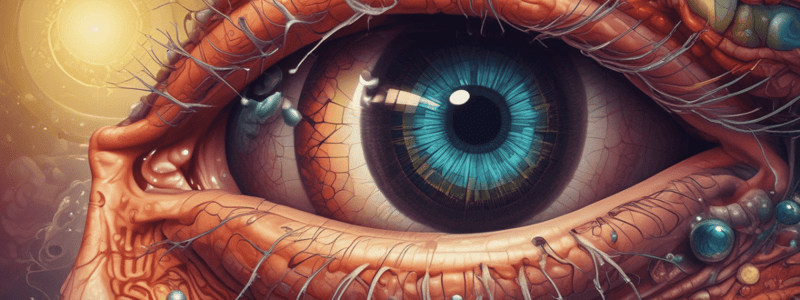Podcast
Questions and Answers
What is the mechanism of immune privilege that prevents the passage of cells from the blood to the anterior eye?
What is the mechanism of immune privilege that prevents the passage of cells from the blood to the anterior eye?
- Immunosuppressive molecules
- Lymphatic drainage
- Tight junctions between cells (correct)
- Major histocompatibility (MHC) molecules
The eye has a well-developed lymphatic drainage system.
The eye has a well-developed lymphatic drainage system.
False (B)
What is the result of exposure of the anterior chamber to a foreign antigen?
What is the result of exposure of the anterior chamber to a foreign antigen?
Induction of suppressor immunity
Anterior chamber-associated immune deviation (ACAID) is mediated by specific _______________ and NKT cells.
Anterior chamber-associated immune deviation (ACAID) is mediated by specific _______________ and NKT cells.
What is the function of immunosuppressive molecules in the eye?
What is the function of immunosuppressive molecules in the eye?
Match the following mechanisms of immune privilege with their descriptions:
Match the following mechanisms of immune privilege with their descriptions:
The eye has a high expression of major histocompatibility (MHC) molecules.
The eye has a high expression of major histocompatibility (MHC) molecules.
What is the result of induction of antigen-specific suppressor CD8+ T-cells and regulatory T-cells?
What is the result of induction of antigen-specific suppressor CD8+ T-cells and regulatory T-cells?
What is the mechanism by which the host epithelium responds to a graft in epithelial rejection?
What is the mechanism by which the host epithelium responds to a graft in epithelial rejection?
The presence of bone marrow-derived cells in the host cornea at the time of surgery contributes to a lower rejection rate.
The presence of bone marrow-derived cells in the host cornea at the time of surgery contributes to a lower rejection rate.
What is the primary function of the immune cells recruited into the cornea through limbal circulation?
What is the primary function of the immune cells recruited into the cornea through limbal circulation?
What is the result of the proliferation of T-regulatory cells specific to the antigen?
What is the result of the proliferation of T-regulatory cells specific to the antigen?
Corneal transplantation is not a successful procedure.
Corneal transplantation is not a successful procedure.
The capacity of the graft to induce _______________________ is a mechanism that contributes to immune privilege.
The capacity of the graft to induce _______________________ is a mechanism that contributes to immune privilege.
Which type of rejection is characterized by subepithelial infiltrates with leukocytes?
Which type of rejection is characterized by subepithelial infiltrates with leukocytes?
What is the main reason for avoiding immune response in the eye?
What is the main reason for avoiding immune response in the eye?
What is the role of the aqueous humor in maintaining immune privilege in the eye?
What is the role of the aqueous humor in maintaining immune privilege in the eye?
The absence of __________ vessels in the graft and its bed contributes to immune privilege.
The absence of __________ vessels in the graft and its bed contributes to immune privilege.
Match the following immune response mechanisms with their functions:
Match the following immune response mechanisms with their functions:
Match the following types of rejection with their characteristics:
Match the following types of rejection with their characteristics:
The presence of MHC-antigens on graft cells enhances immune privilege in the eye.
The presence of MHC-antigens on graft cells enhances immune privilege in the eye.
What is the name of the surgical procedure that involves replacing the diseased or damaged cornea with a healthy donor cornea?
What is the name of the surgical procedure that involves replacing the diseased or damaged cornea with a healthy donor cornea?
The eye has a well-developed lymphatic drainage system.
The eye has a well-developed lymphatic drainage system.
What is the indication for corneal transplantation when the cornea is likely to break open?
What is the indication for corneal transplantation when the cornea is likely to break open?
What is the primary function of immune privilege?
What is the primary function of immune privilege?
The anterior chamber is not immune privileged.
The anterior chamber is not immune privileged.
What is an allograft?
What is an allograft?
The eye is protected from immune reactions that are potentially dangerous in the _______________________ chamber.
The eye is protected from immune reactions that are potentially dangerous in the _______________________ chamber.
Which of the following is NOT an example of an immune privileged site?
Which of the following is NOT an example of an immune privileged site?
Corneal graft rejection is a major concern in eye transplantation.
Corneal graft rejection is a major concern in eye transplantation.
Match the following immune privileged sites with their characteristics:
Match the following immune privileged sites with their characteristics:
What is the purpose of immune privilege in the eye?
What is the purpose of immune privilege in the eye?
What is the primary mechanism of direct pathway in corneal graft rejection?
What is the primary mechanism of direct pathway in corneal graft rejection?
Corneal graft rejection is always symptomatic.
Corneal graft rejection is always symptomatic.
What are the two mechanisms of corneal graft rejection?
What are the two mechanisms of corneal graft rejection?
The indirect pathway of corneal graft rejection leads to ______ hypersensitivity.
The indirect pathway of corneal graft rejection leads to ______ hypersensitivity.
Match the following risk factors with their corresponding descriptions:
Match the following risk factors with their corresponding descriptions:
What is the primary site of antigen processing in corneal graft rejection?
What is the primary site of antigen processing in corneal graft rejection?
ABO blood type incompatibility is a confirmed risk factor for corneal graft rejection.
ABO blood type incompatibility is a confirmed risk factor for corneal graft rejection.
What is the common complaint associated with corneal graft rejection?
What is the common complaint associated with corneal graft rejection?
Flashcards are hidden until you start studying
Study Notes
Mechanisms of Immune Privilege
- Lack of lymphatic drainage in the eye
- Anatomical features: blood barrier, no blood vessels or inflammatory cells, protected by conjunctiva and eyelids
- Presence of immunosuppressive molecules or cell surface receptors that inhibit T-cell proliferation and suppress interferon secretion
- Lower expression of major histocompatibility (MHC) molecules
- Development of tolerance against antigens through anterior chamber-associated immune deviation (ACAID)
Anterior Chamber-Associated Immune Deviation (ACAID)
- Exposure of the anterior chamber to a foreign antigen induces suppressor immunity
- Induction of antigen-specific suppressor CD8+ T-cells and regulatory T-cells (suppressor CD4+ T-cells)
- Induction of non-complement-fixing antibodies mediated by specific macrophages
- Presentation of inoculated antigen to a cluster of B-cells, NKT cells, CD4+ and CD8+ T cells in the spleen
Corneal Graft Rejection
- Types of rejection: epithelial, subepithelial, and both types
- Immune mechanism: inflamed cornea contributes to erosion of immune privilege
- Bone marrow-derived cells are recruited into cornea through limbal circulation
- These cells can process and present antigens, leading to rejection
Why Immune Privilege?
- Normal symptoms of inflammation (redness, swelling, and pain) can lead to dysfunction in the eye (loss of vision)
- Certain circumstances (e.g., trauma, infection, genetics) can lead to dysfunction of the regulatory mechanisms of the eye, leading to immune inflammatory diseases
Corneal Transplantation
- Also known as penetrating keratoplasty
- Over 40,000 procedures done per year in the USA
- Indications: severe scarring of cornea, cornea likely to break open, severe damage involving cornea and lens
- Corneas are removed from donors who have been declared dead
Why is Corneal Transplantation Successful?
- Due to corneal immune privilege
- Absence of blood and lymph vessels in the graft and its bed
- Absence of MHC class II+ antigen presenting cells in the graft
Risk Factors for Corneal Graft Rejection
- Host corneal vascularisation
- Larger and eccentric grafts
- Presence of donor epithelium upon transplantation
- History of previous graft failure of any cause
- Bilateral penetrating keratoplasty
- Pre-transplantation corneal tissue media and preservation
- Host age (lower risk with age >60 y, much higher risk in infants)
- Human leukocyte antigen A (HLA-A) and human leukocyte antigen (HLA-B) and ABO blood type incompatibility
Studying That Suits You
Use AI to generate personalized quizzes and flashcards to suit your learning preferences.



